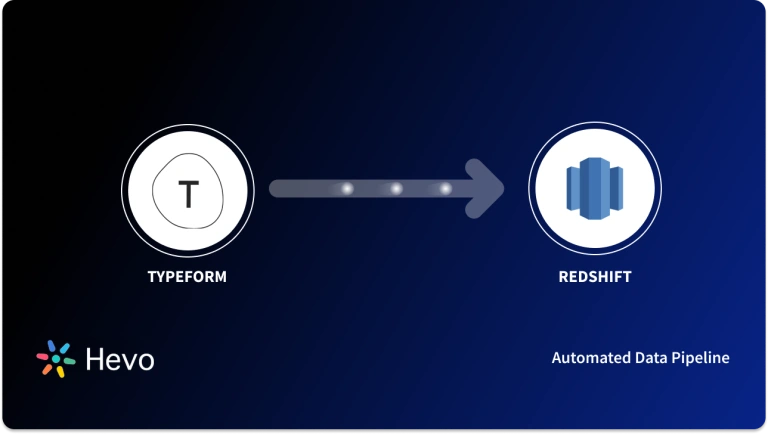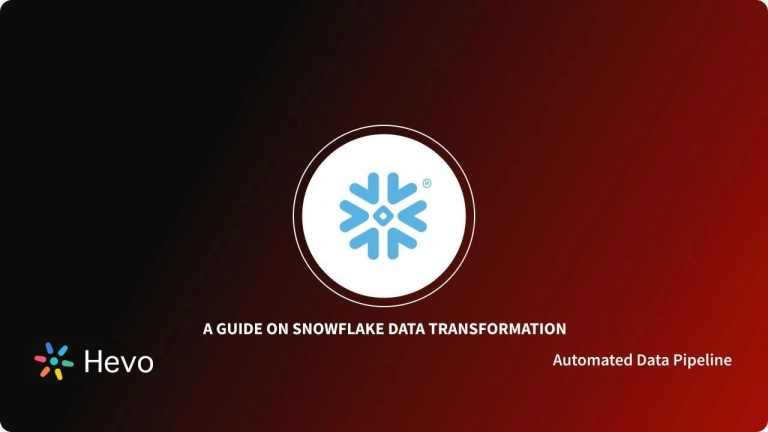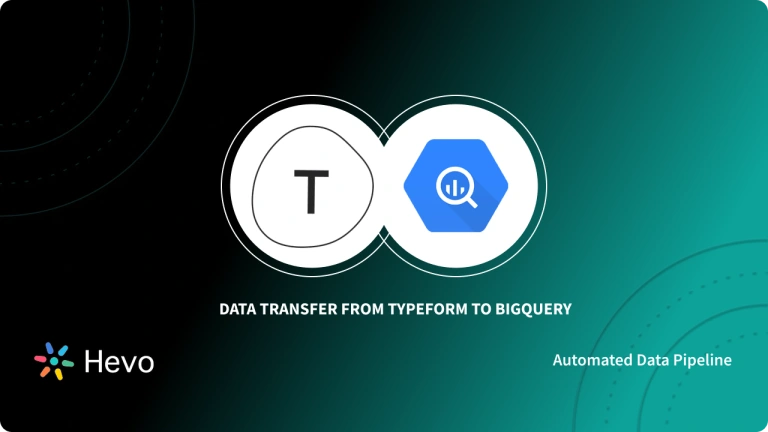 Key Takeaways
Key TakeawaysLoading Typeform data into Snowflake can be handled in two ways:
Method 1: No-Code with Hevo Data
Step 1: In Hevo’s UI, add Typeform as a source.
Step 2: Add Snowflake as a destination.
Benefit from real-time sync, auto schema mapping, and transformations—no code required.
Method 2: Manual via APIs & Snowflake Commands
Step 1: Fetch responses with GET https://api.typeform.com/forms/{form_id}/responses.
Step 2: Transform the JSON into tabular rows (e.g. using pandas).
Step 3: Upload the prepared CSV with PUT into a Snowflake stage.
Step 4: Run COPY INTO to load it into your table.
Step 5: Use the submitted_at field for incremental updates.
Unlock the full potential of your Typeform data by integrating it seamlessly with Snowflake. With Hevo’s automated pipeline, get data flowing effortlessly—watch our 1-minute demo below to see it in action!
Typeform helps businesses build interactive forms and surveys through which they can communicate with customers easily. Since it allows organizations to collect customer data with millions of users, it is essential to export data from Typeform and store it in Data Warehouses for further analysis. Snowflake is one such data warehouse service that allows you to store your Typeform data. You can use APIs or third-party ETL (Extract, Load, and Transform) tools to integrate your Typeform data into Snowflake.
In this article, you will learn to connect Typeform with Snowflake using APIs and manual processes. You will also learn about a fully automated way to load data from Typeform to Snowflake!
Table of Contents
What is Typeform?
Developed in 2012, Typeform is widely used for collecting and sharing information easily by creating interactive forms and surveys. In other words, Typeform is a platform where businesses can create visually appealing forms. Organizations use Typeform to build communication with customers through effective forms and surveys. With Typeform, customers can experience a real one-to-one conversation that keeps them engaged and entertained to complete the surveys.
Forms and surveys built with Typeform are interactive, attracting your customers to answer the questions and complete the surveys. Typeform allows users to store the collected data in various formats, including .csv and .xlsx, for further analysis.
Key Features of Typeform
- Interactive Designs: Typeform consists of interactive designs which attract customers to answer the questions and finish the surveys. It includes built-in designs, templates with drag and drop functionality, and colourful and user-friendly forms which engage the customer.
- Personalize Journeys: The Logic Jump is an intelligent feature of Typeform that prompts questions depending on the customer’s previous answers. It helps to collect data in less time by skipping irrelevant questions.
What is Snowflake?
Developed in 2012, Snowflake is a fully managed Cloud Data Warehouse available to customers in the form of Software-as-a-Service (SaaS) or Database-as-a-Service (DaaS). Users need not worry about backend or administrative work such as installation, maintenance, configuration, and more since they are performed automatically by Snowflake. With Snowflake, users can also choose a Cloud provider from Microsoft Azure, Amazon Web Service, and Google Cloud Storage to store their data.
Key Features of Snowflake
- Caching Results: Snowflake enables an essential feature that caches results at different levels, meaning the results can last for 24 hrs after the query is executed. Therefore, if the same query is executed, the results are quickly delivered.
- UNDROP Command: It might happen at times that users may delete the wrong tables. Therefore, to retrieve these tables, you can use the UNDROP command. Although you can use the traditional recovery and backup method, they are time-consuming. The UNDROP command is a better and quicker alternative.
- Data Sharing: The Data Sharing feature in Snowflake allows you to share items from one database account to another without creating duplicates. This feature guarantees more storage space and less computation, resulting in faster data accessibility.
Read about Snowflake Cortex functions in detail, along with Snowflake Warehouse Architecture.
Method 1: Connecting Typeform to Snowflake using Hevo
Hevo Data, an Automated Data Pipeline, provides you with a hassle-free solution to load data from Typeform to Snowflake and 150+ Data Sources within minutes with an easy-to-use no-code interface. Hevo is fully managed and completely automates the process of not only loading data but also enriching the data and transforming it into an analysis-ready form without having to write a single line of code.
Method 2: Connecting Typeform to Snowflake with APIs
This method would be time-consuming and somewhat tedious to load data from Typeform to Snowflake. This is a long process and you have to be very careful of the order while executing, even a small mistake requires the whole process to be run again.
Method 1: Automated Typeform to Snowflake Migration using Hevo Data
All the limitations of manual methods can be overcome by using an Automated Data Pipeline like Hevo. Connecting Typeform to Snowflake using Hevo is a simple two-step process. Hevo Data is a No-code Data Pipeline solution that can help you seamlessly replicate data in real-time from 100+ Data Sources (Including 40+ free sources) like Typeform to your desired destination like Snowflake, other Data Warehouses, or Databases in a completely hassle-free & automated manner.
Step 1: Configuring Typeform as a Source in Hevo
Perform the following steps to configure Typeform as the Source in your Pipeline:
- Step 1.1: Select Typeform on the Select Source Type page,
- Step 1.2: In the Configure your Typeform account page, click + ADD TYPEFORM ACCOUNT and enter your credentials.
- Step 1.4: Click TEST & CONTINUE.
Step 2: Configure Snowflake as a Destination in Hevo
- Step 2.1: On the Add Destination page, select Snowflake as the Destination type.
- Step 2.2: In the Configure your Snowflake Warehouse page, specify the details according to the image.
- Step 2.3: Click TEST CONNECTION.
This will create a robust connection from Typeform to Snowflake.
Method 2: Connecting Typeform to Snowflake with APIs
Follow the below steps to connect Typeform with Snowflake using APIs.
Step1: Getting Data out of Typeform
Typeform provides several APIs that you can use to data from the websites. For example, to retrieve the form response, you can call GET using the below command.
https://api.typeform.com/forms/{form_id}/responsesBy using the queries like above, you can get the sample data of Typeform.
Step 2: Preparing Typeform Data
If you do not have a data structure to store your collected data, you have to create a schema for the data. You need to identify the data type as Integer, String, DateTime, and more for each value in the response form and then build a table for each of them. Here’s an example of how to transform the Typeform JSON data into a structured format:
import pandas as pd
# Sample JSON response from Typeform (this should come from your response data)
data = {
'items': [
{
'submitted_at': '2023-10-08T10:00:00Z',
'answers': [
{'field': {'id': 'A1', 'type': 'text'}, 'text': 'Answer1'},
{'field': {'id': 'A2', 'type': 'number'}, 'number': 42}
]
},
# Add more items as needed
]
}
# Extracting relevant data
rows = []
for item in data['items']:
row = {'submitted_at': item['submitted_at']}
for answer in item['answers']:
field_id = answer['field']['id']
field_value = answer.get('text') or answer.get('number') # Adjust based on field type
row[field_id] = field_value
rows.append(row)
# Convert to DataFrame for easier handling
df = pd.DataFrame(rows)
print(df)Step 3: Preparing Data for Snowflake
You need to prepare your data for loading depending on its structure. Go through the supported datatypes for Snowflake and ensure that you map them correctly.
Note: When loading JSON data into Snowflake, you do not need to define a schema in advance.
Step 4: Loading Data into Snowflake
To load your data, you can refer to the data loading overview section in Snowflake’s documentation. If you want to load data in small volumes, you can use the Snowflake UI. However, you can also use the two main commands to load data into Snowflake.
- Use the PUT command.
- Use the COPY INTO table command to load prepared data into an awaiting table.
import snowflake.connector
# Set up Snowflake connection
conn = snowflake.connector.connect(
user='YOUR_USER',
password='YOUR_PASSWORD',
account='YOUR_ACCOUNT'
)
cursor = conn.cursor()
# Step 1: PUT command to upload the file to Snowflake's staging area
cursor.execute("PUT file://typeform_data.csv @%YOUR_TABLE_NAME")
# Step 2: COPY INTO command to load data into your Snowflake table
copy_query = """
COPY INTO YOUR_TABLE_NAME
FROM @%YOUR_TABLE_NAME/typeform_data.csv
FILE_FORMAT = (TYPE = 'CSV' FIELD_OPTIONALLY_ENCLOSED_BY = '\"' SKIP_HEADER = 1)
"""
cursor.execute(copy_query)
# Close the connection
cursor.close()
conn.close()Step 5: Keeping Typeform Data Up to Date
You can get the script for the data you want to retrieve and successfully load it to the Data Warehouse at this stage. But getting this data is not enough, as you need to update it. However, when you update this data, your existing data can be replicated. As a result, this process is resource-intensive and requires a lot of time.
Therefore, it becomes essential to build in a way that it can identify incremental updates to your data. Typeform consists of API results, with fields like submitted_at, allowing you to identify records since your last update. Once you have taken your new or updated data into a Snowflake account, you can set up the continuous loop for pulling down new data as it appears.
Also Read: Typeform to BigQuery and Typeform to Redshift
Limitation of Manual Methods for Connecting Typeform to Snowflake
- Connecting Typeform to Snowflake directly leveraging APIs is time-consuming and a bit complex. If you have the required skills or technical expertise, you can build this integration by maintaining a script as above.
- Even manually exporting data from Typeform and importing data into Snowflakes using the web interface is challenging. Although this process is very straightforward, it does not help you extract real-time data.
Therefore, to avoid the above limitations, you can use ETL tools such as Hevo to create easily automated pipelines from Typeform to Snowflake to store and analyze real-time data.
Conclusion
Typeform is like an online surveying tool that allows businesses to build delightful interactions with customers for collecting data in a specific format. Businesses can then use this data to analyze Product Development, Business Intelligence, Customer Journey, Actionable Insights, and more. This article provided 3 different methods that can be used for connecting Typeform to the Snowflake account.
There are various trusted sources that companies use as it provides many benefits, but, transferring data from it into a data warehouse is a hectic task. The Automated Data Pipeline helps in solving this issue and this is where Hevo comes into the picture. Hevo Data is a No-code Data Pipeline and has awesome 100+ pre-built Integrations such as Typeform & Snowflake that you can choose from.
SIGN UP for a 14-day free trial and see the difference! Share your experience learning about loading data from Typeform to Snowflake in the comments section below.
FAQs
1. How to insert JSON data into Snowflake?
JSON data can be imported into Snowflake by storing a file and then uploading it to a stage using PUT. It will then be loaded into a table using the COPY INTO command. Snowflake automatically parses and stores JSON data in its VARIANT column type.
2. How to pull data from Typeform?
To pull data from Typeform, use the Typeform API with a GET request to the endpoint https://api.typeform.com/forms/{form_id}/responses. Replace {form_id} with your form’s ID and authenticate with your API token to retrieve form responses in JSON format.
3. Where does Typeform data go?
Typeform’s servers will store the data from Typeform, and it will be accessible to users either through the web platform or through its API to use outside in apps such as loading into databases for analysis and reporting, like in Snowflake.










